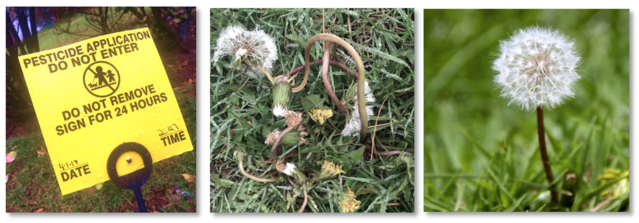
Health
Is There a Link Between Lawn Care and Mental Health?
We love a beautiful lawn, but what is the mental and physical cost?
Posted May 4, 2019

Near my home a few weeks ago, I found this sign (pictured on the left) while running outside with my dog. The next picture on the right is a picture I took of dandelions that are found in a lawn just treated with pesticides and herbicides, and the last picture is a dandelion plant* with no pesticide application. Do you see the difference between the dandelions on these two lawns?
Which lawn would you want your child or pet rolling around in?
Lawns and Pesticides
Lawns were first developed in the 17th century in England. Landowners planted them to flaunt their wealth, for only people with extra money could hire the help needed to hand cut and water these tracks of grass. As a result, lawns became a sign of status, one that still exists in suburbia today.
The sign suggests that it should not be removed for 24 hours in order to ensure safety by warning people, and their pets, to avoid the poison. This doesn’t really make any sense: Persistent pesticides and herbicides can take up to 100 days to break down. Some studies suggest it takes years to break down certain herbicides. In that time, anyone nearby is exposed to toxic chemicals.
At least the pesticide applicator placed a sign for a day. Most of the time, these toxic substances are put down without anyone being informed.
The word pesticide is a collective term for a wide variety of chemicals intended to kill unwanted insects, plants, molds, and rodents. Unfortunately, to keep things pretty and perfect these weed killers and pesticides are liberally used virtually everywhere. As a result, we eat and drink them, inhale them, and absorb them through our skin.
Children and Pets at Risk
It is possible that those of us who are low to the ground are most at risk: young children and our pets. Kids and pets love to roll around on lawns and probably spend the most time outside of all of us. Multiple studies have shown how pesticide exposure in pregnancy and childhood is a known factor in cancer in children, including pediatric leukemia1 and brain tumors.2 Harvard research has also shown an association with insecticides and childhood cancer.3 Chromosomes (the gene clusters in our cells) can become rearranged by the toxins and cause these types of cancer to occur. While there are fewer studies of animals, it has been shown that nasal passages and the mouth are typical routes of entry for dogs and cats who like to sniff their way through the world. Available studies from Europe show pesticides are responsible for 37.3 percent of all suspected domestic animal poisoning enquiries, with our dogs representing almost 75 percent of these.4
Adults at Risk Too
In March 2019, for the first time in a landmark ruling, Monsanto was ordered to pay a California man $80 million when his lymphoma was linked to the use of Roundup–a type of glyphosate and the most common pesticide available.5 This man, like many people, used Roundup to control weeds on his property. Monsanto, owned by the Bayer company, continues to claim that Roundup is safe. They argue that much of the research does not clearly show direct cause. This is true, but it is important to remember that insidious chemicals like this cause cancers via multiple mechanisms—such as changes in hormones and the microbiome–and that cancers also have genetic underpinnings that take a few decades to become apparent. It can be very hard to prove causation by one chemical when there are so many other factors at play. What we need is more independent research–not just studies sponsored by the companies that make these products. Dr. Phil Landrigan, a recognized expert in environmental health at Mt. Sinai in New York, discusses this in a 2018 paper you can find here.6
Our Mental Health at Risk
Regarding mental health, a Scientific American report cited epidemiologic studies connecting pesticide use in farmers with significant increases of depression.7 Those who used organochlorine pesticides or fumigants had an 80 to 90 percent increase in risk of depression. The report also reviewed studies in France, which showed a 200 percent increase in depression treatment for farmers using herbicides. Animal studies suggest these compounds can affect levels of brain neurotransmitters (the molecules of emotion) as well as change the brain's ability to repair itself. Other studies show activation of brain neurotransmitters, which, I believe, may also contribute to anxiety levels.
Glyphosate-based herbicidal weed killers have increased tremendously over the past few decades–a whopping 100-fold from 1974 to 2014.8 Animal studies have also suggested that such herbicides as glyphosate may not only be toxic to the brain, but may also significantly disrupt our microbiome, the good bacteria in the digestive tract. Both chronic and subchronic exposure to these chemicals induced anxiety and depression-like behaviors in mice. Specific healthy bacteria, such as lactobacillus, decreased.9
Since the digestive tract is an important factor in brain inflammation and neurotransmitter production, it is likely that this disruption in both the brain and the digestive tract creates a higher chance of mental health problems in those exposed.
Steps You Can Take?
Best advice: Go natural with your lawn as much as possible.
I realize it may not look as perfect, and there may be a few more bugs, but it may add a few years of better health to your life and the life of your kids and pets. You can do your own weeding, which is one of the best exercises to build healthy bones and prevent osteoporosis.10 If you have a landscaper–tell him or her that you do not want any more pesticides, herbicides, or chemical fertilizers. Ask for a list of any compounds applied to your lawn and garden areas.
The “no-mow” movement is gaining traction–you can learn more about it here.11 Besides its being better for our health, it is also good for the environment, as lawns themselves strip away organic material from the earth's surface and create runoff into rivers and oceans .
Also, remember to take your shoes off before coming in the house and switch to natural cleaners to help lower toxins inside your home.
*Dandelions are actually very healthy for the liver12, 13 and have been traditionally used to help detoxify the body. Maybe instead of getting rid of these weeds, we should start eating more of them. :)



